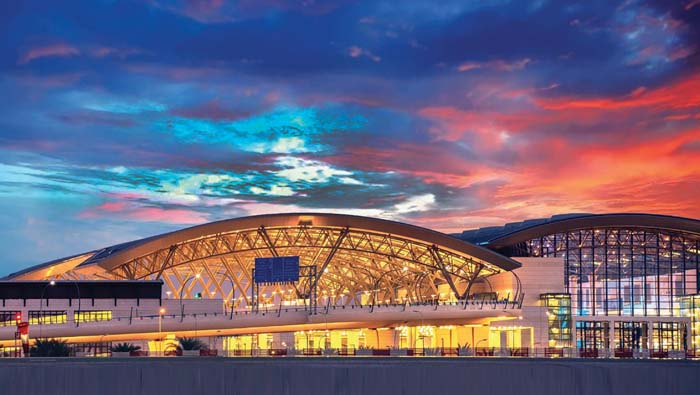
Muscat: Some 16 million passengers are expected to arrive at Muscat’s new international airport by the end of 2018, making it a record year for the Sultanate, Oman’s top airport official has said, after receiving one of the world’s most prestigious air travel awards.
The airport was awarded the “Best Leading Airport 2018” at the World Travel Awards.
The award ceremony was held in Lisbon.
Speaking exclusively to the Times of Oman, Ayman bin Ahmed Al Hosni, CEO of Oman Airports Management Company (OAMC), has said that 2018 was already an unprecedented year in terms of passenger arrivals, and as the country continues to expand its airport services, many more passengers will arrive in the future.'
**media[971251]**
“By the end of 2018, the total number of passengers at the airport is expected to reach 16 million, bringing a new record to the airport in Oman,” he said.
“We are committed to playing a pivotal role in achieving the government’s ambitious national logistics strategy to become one of the top 20 airports in the world by 2020.”
According to data from the National Centre for Statistics and Information (NCSI), Oman received 14,034,865 passengers from flights that landed in Muscat.
At the end of October 2018, the number of passengers landing in Muscat was at 12,700,925. NCSI statistics also showed that 114,258 flights landed in Muscat last year.
Al Hosni added, “The total number of flights to Muscat International Airport between January and October 2018 was 89,368, an increase of 5.2 per cent over the previous year, and we affirm that the travel and tourism sector in the Sultanate is growing steadily after the opening of the new Muscat International Airport.”
“Muscat International Airport strives to enrich the customer experience with the best service,” he said. “We are aware that the airport is the first thing that visitors to the Sultanate encounter as soon as they arrive, so we sought to reflect on the true meaning of Oman’s natural hospitality and the natural beauty of Oman.”
Airport development in Oman is considered to be an important node in the development of tourism in the Sultanate, one of the major areas of expansion under the Tanfeedh programme for economic development to wean the country off traditional fossil fuel-based sources of income such as oil and gas.
Tourism is earmarked for expansion, alongside agriculture and fisheries, mining and energy, transport and logistics, and manufacturing, and Al Hosni added that Oman winning the prestigious “Best Leading Airport 2018” award at the World Travel Awards in Lisbon, Portugal, only supported the Sultanate’s commitment to driving tourism forward.
“This prestigious award underscores our efforts to write a new chapter in our journey towards excellence,” he said. “Infrastructure is an essential element to deliver quality services that meet the aspirations of our customers and manage the Sultanate’s ports professionally and efficiently. The commercial operation of the new Muscat International Airport began on March 20 with a total area of 580,000 square metres with a capacity of 20 million passengers annually.
Al Hosni added, “Since its opening, the airport has received international praise for its architecture, reflecting the traditional Omani character, modern technology and the exceptional experience of travellers. With an expansion capacity of 80 million passengers per year, the airport is designed to meet the highest standards of quality and service as per the classification approved by the International Air Transport Association (IATA).”
The award was conferred upon Muscat International Airport in part, due to its world-class facilities that have already been slated for expansion as the country continues to grow and develop.
Muscat International Airport, which is overseen by the Ministry of Transport and Communications, has a passenger terminal, a 4-km runway, a 103-metre air observation tower, an air cargo terminal, and a catering terminal, as well as aircraft maintenance building and other airport terminals. The building includes 118 booths to complete the travelling procedures and 82 counters for passports and immigration control by Royal Oman Police, in addition to a host of retail services across the airport.
It has two gates for big aircraft, such as the Airbus 380 and Boeing 747, which are connected to bridges to transport passengers. The building contains conveyor belts for baggage handling, with a capacity of 5,200 bags per hour and a length of 11.2 km. The building includes lounges for VIPs, first and business class passengers, offices for airlines and rent-a-car operators, in addition to offices for tourism information and assorted services.
Following the accolade, the Sultanate, represented by Oman Airports, will host the 2019 World Travel Awards.
The Sultanate will welcome guests and participants from all over the world in Muscat to honour the world’s leading travel and tourism leaders.
“We are very proud of this achievement and look forward to hosting this important event in the Sultanate, which will undoubtedly strengthen the Sultanate’s position as an ideal destination to host the most important international events of this kind, which will contribute to the promotion of the strategy of diversification of the national economy,” said Al Hosni.
The building also accommodates a four-star hotel with 90 rooms, swimming pools, and food lounges, with space for adding 90 more rooms in the future. There are 29 gates linked to 40 bridges to transport passengers to and from the aircraft, and 16 ground gates to transport passengers by bus. It has 59 parking slots for aircraft.
The air cargo building has a capacity of over 32,000 square metres with a capacity of 350,000 tonnes per annum that will be increased to 500,000 tonnes. It has a building for handling goods that ensure the smooth handling of goods containers, as well as 4,722 car parking spaces, including 2,054 shaded parks that are connected to shaded aisles to connect to passenger terminals. It has also areas for buses stations, in addition to buildings for allied services and facilities.